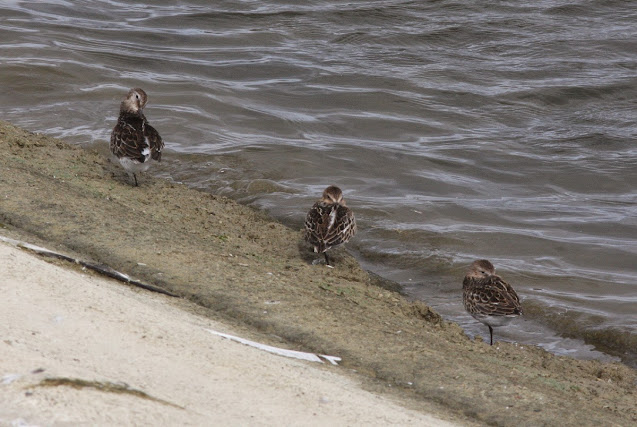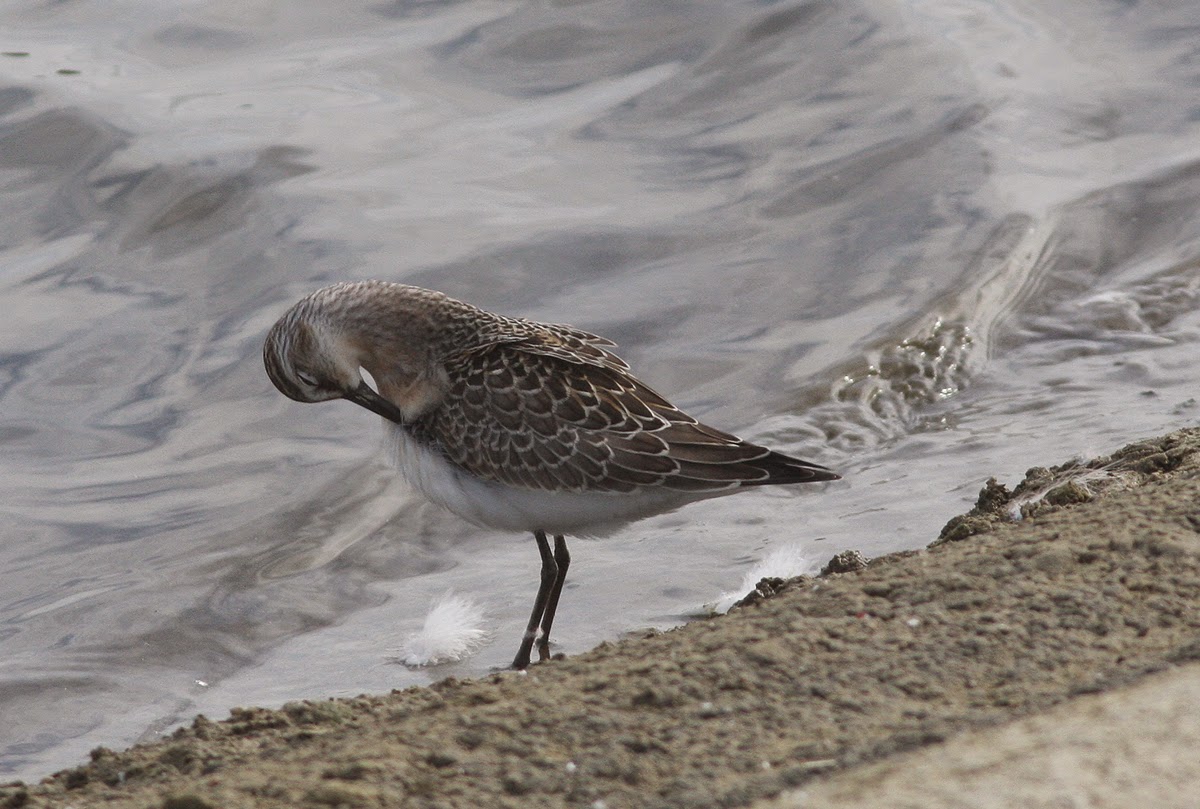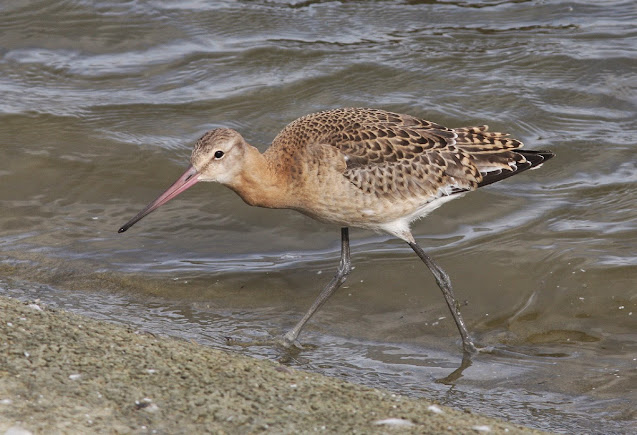Farmoor Reservoir on a windy but mild Friday was the unlikely resurrection of my return to birding. Enough of dragonflies and butterflies wonderful as they are. They have served their purpose well and provided a mild stimulation for me through the summer months but now the first serious birding for some time was afoot in the shape of two juvenile Curlew Sandpipers gracing the concrete shore of 'The Causeway' at Farmoor Reservoir.
Curlew Sandpipers are one of the more elusive waders to pass through Farmoor and indeed in some years are completely absent. The individuals that do arrive and stop over for a day or two are usually juveniles and this often signifies a successful breeding season in the Siberian wilderness where they were born, with numbers of them making a brief appearance to stop, feed and rest on their way through the UK to their winter home in southern Africa. What a journey they make, starting from Siberia then moving across Europe and finally transiting or circumventing the vastness of the African continent. I remember some years ago seeing literally thousands at a place called Knysna on the east coast of South Africa in what was our winter but South Africa's summer.
They are a supremely elegant wader, perfectly proportioned with a long curved bill complemented by long legs and a slimline body. Slightly larger than their close relative the Dunlin they impart an almost aristocratic air and presence when associating with the dumpy and more mundane Dunlin forever fussing and fiddling at the waters edge whilst the Curlew Sandpiper feeds at a less frenetic rate and is almost sedate in comparison.
Juvenile Curlew Sandpipers possess not only a beauty of form but their plumage imparts a dapper air to them. Usually pristine at this time of year, the neat scalloping on the grey upperparts and the delicate peachy blush on their breasts again contrasts favourably with the messy grey and brown transitional plumage of the juvenile Dunlins that were feeding with them today at the concrete edge.
The water level on the smaller basin - Farmoor One - has receded so that at least four metres of normally submerged concrete is now exposed.
This concrete has rich pickings in the algae and muddy sediment that has been exposed at the water's edge and I watched the Curlew Sandpipers delicately probing with their bills and extracting small worms and other invertebrates. Typically they were tame and unafraid of human presence and provided I did not make any sudden movements they would happily carry on feeding right in front of me.
This concrete has rich pickings in the algae and muddy sediment that has been exposed at the water's edge and I watched the Curlew Sandpipers delicately probing with their bills and extracting small worms and other invertebrates. Typically they were tame and unafraid of human presence and provided I did not make any sudden movements they would happily carry on feeding right in front of me.
Having taken many pictures I ceased and sat on the wall and contemplated the long dangerous journey that lay before them as they went about their lives and for this brief moment came to be in the middle of England on a mundane reservoir. What landscapes must they have encountered on their first journey south, crossing the forests and steppes of Russia, the fjords and mountains of Scandinavia and then arriving above the UK to find the concrete jungles of our big cities and little land that did not show sign of human habitation. High in the sky they see the reservoir which to them will provide a brief but welcome sanctuary to rest and feed before continuing across southern Europe. Do they go across land? Surely some do as how else have they come to be at Farmoor but others can feed and rest on the seashores of southern Europe and the African coast. I can but imagine their lives and where they will go, forever fearful and on the alert for there are many dangers but free in a way I can never know.
I watched one briefly sleeping, then preening and as I sat watching it in the sun felt just a little sense of that wild spirit, that comes with the call of open, uninhabited spaces and empty sandy strands and that our regimented over regulated lives has all but quelled.
The sandpipers moved on as did I, both of us going in opposite directions. I wandered down the causeway and gawped at the huge number of feral geese sitting under the wave wall away from the wind. The numbers are becoming truly prodigious and no doubt sooner or later calls will be issued for some sort of control of their numbers to be exercised. The amount of goose crap and myriad discarded feathers will surely attract the attention of some jobsworth who will decide that the proverbial little old lady could slip on a goose turd and then where would we be?
Well for now they were living in peace and in amongst them was another elegant wader, this one much larger than the Curlew Sandpipers. It was a juvenile Black tailed Godwit delicately threading its way through the Canada and Greylag Geese as it eked out a living at the waters edge. It paid no heed to me but was wary of the geese and rightly so as the Canada's would lunge with their beaks on outstretched necks as it passed by. Occasionally it would wade up to its belly in the water and on a couple of occasions actually swam as it circumvented yet another irascible goose.
 |
| I counted the number of Canada Geese. It came to an astonishing 701 |
I carried on around the smaller reservoir and found a small flock of six Common Sandpipers and a Ringed Plover in the far northwest corner dodging the waves and piles of rotting feathers, the latter no doubt discarded from the gull roost that occurs here every night.
The waders, like diamonds that come from the earth were the prize to be found amongst all the debris
























No comments:
Post a Comment